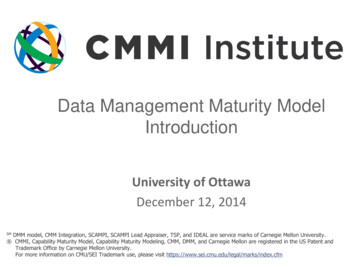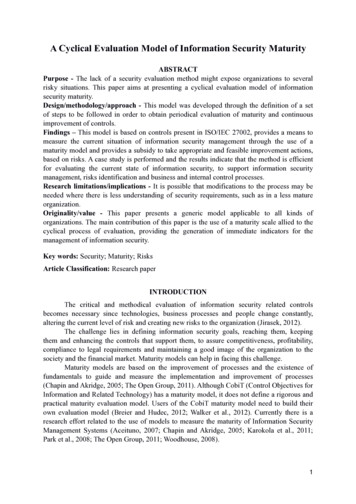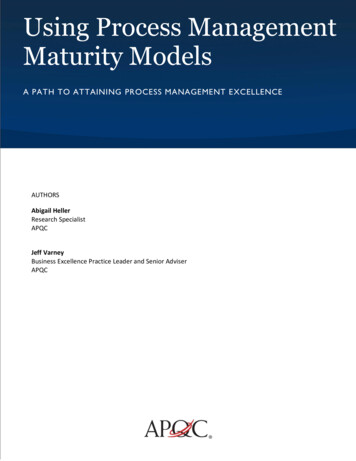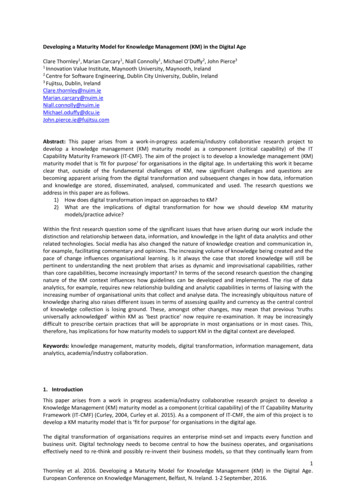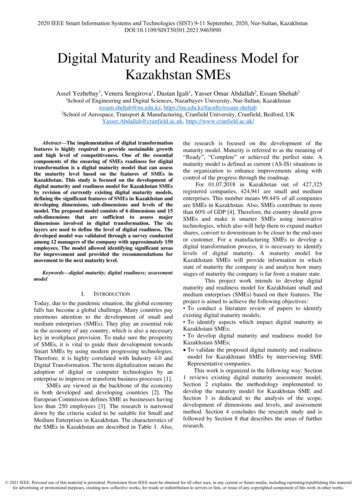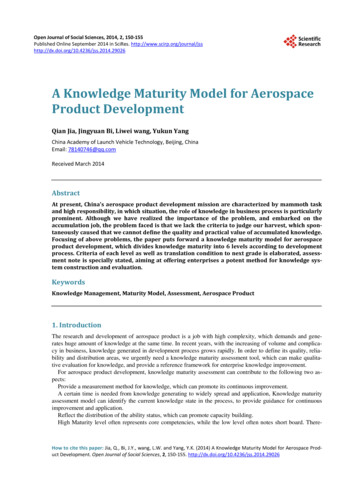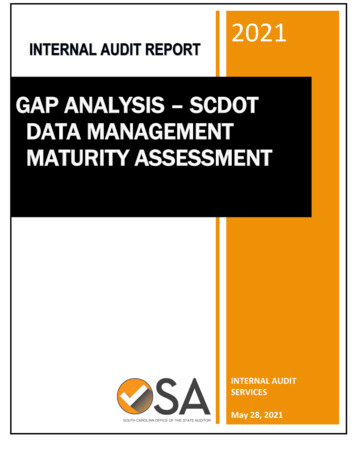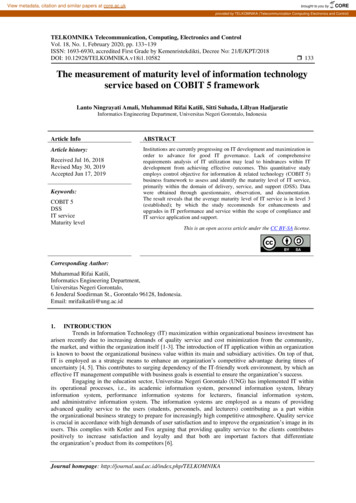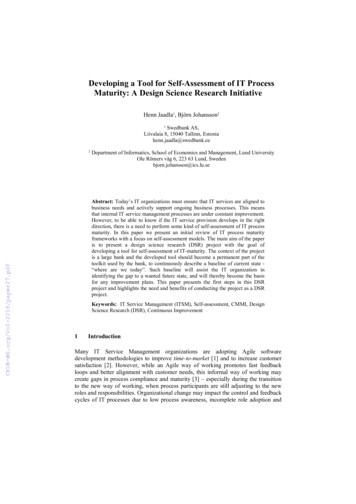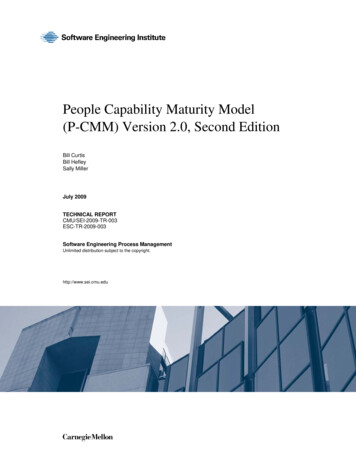
Transcription
People Capability Maturity Model(P-CMM) Version 2.0, Second EditionBill CurtisBill HefleySally MillerJuly 2009TECHNICAL REPORTCMU/SEI-2009-TR-003ESC-TR-2009-003Software Engineering Process ManagementUnlimited distribution subject to the copyright.http://www.sei.cmu.edu
This report was prepared for theSEI Administrative AgentESC/XPK5 Eglin StreetHanscom AFB, MA 01731-2100The ideas and findings in this report should not be construed as an official DoD position. It is published in theinterest of scientific and technical information exchange.This work is sponsored by the U.S. Department of Defense. The Software Engineering Institute is a federallyfunded research and development center sponsored by the U.S. Department of Defense.Copyright 2009 Carnegie Mellon University.NO WARRANTYTHIS CARNEGIE MELLON UNIVERSITY AND SOFTWARE ENGINEERING INSTITUTE MATERIAL ISFURNISHED ON AN "AS-IS" BASIS. CARNEGIE MELLON UNIVERSITY MAKES NO WARRANTIES OFANY KIND, EITHER EXPRESSED OR IMPLIED, AS TO ANY MATTER INCLUDING, BUT NOT LIMITEDTO, WARRANTY OF FITNESS FOR PURPOSE OR MERCHANTABILITY, EXCLUSIVITY, OR RESULTSOBTAINED FROM USE OF THE MATERIAL. CARNEGIE MELLON UNIVERSITY DOES NOT MAKEANY WARRANTY OF ANY KIND WITH RESPECT TO FREEDOM FROM PATENT, TRADEMARK, ORCOPYRIGHT INFRINGEMENT.Use of any trademarks in this report is not intended in any way to infringe on the rights of the trademark holder.Internal use. Permission to reproduce this document and to prepare derivative works from this document forinternal use is granted, provided the copyright and "No Warranty" statements are included with all reproductionsand derivative works.External use. This document may be reproduced in its entirety, without modification, and freely distributed inwritten or electronic form without requesting formal permission. Permission is required for any other externaland/or commercial use. Requests for permission should be directed to the Software Engineering Institute atpermission@sei.cmu.edu.This work was created in the performance of Federal Government Contract Number FA8721-05-C-0003 withCarnegie Mellon University for the operation of the Software Engineering Institute, a federally funded researchand development center. The Government of the United States has a royalty-free government-purpose license touse, duplicate, or disclose the work, in whole or in part and in any manner, and to have or permit others to do so,for government purposes pursuant to the copyright license under the clause at 252.227-7013.).
Table of ContentsList of FiguresiiiAbstractxiii1The People Capability Maturity Model Overview: Background, Concepts, Structure, andUsage11.1 The Process Maturity Framework31.2 Organizational Maturity41.3 What Is the People CMM?51.4 Factors Driving the Demand for the People CMM71.5 What Is the Process Maturity Framework?111.6 Why Did the People CMM Emerge in the Software Industry?141.7 How Is the People CMM Being Applied?162Increasing Organizational Capability Through the People CMM2.1 Maturity Levels in the People CMM2.2 Behavioral Characteristics of Maturity Levels2.2.12.2.22.2.32.2.42.2.53People CMM Process Areas3.1 Process Area3.2 The Process Areas of the People CMM3.2.13.2.23.2.33.2.43.2.54The Initial Level: Maturity Level 1The Managed Level: Maturity Level 2The Defined Level: Maturity Level 3The Predictable Level: Maturity Level 4The Optimizing Level: Maturity Level 5The Architecture of the People CMM4.1 Structural Components of the People CMM4.2 Maturity Levels4.3 Process Areas4.4 Goals4.5 Practices4.65The Initial Level: Maturity Level 1The Managed Level: Maturity Level 2The Defined Level: Maturity Level 3The Predictable Level: Maturity Level 4The Optimizing Level: Maturity Level 54.5.1 Implementation Practices4.5.2 Institutionalization Practices4.5.3 Practice StatementsRequired, Expected, and Informative ComponentsRelationships Among Process Areas5.1 A System of Related Practices5.2 Process Area Threads in the People CMM5.2.15.2.25.2.35.2.4Developing Individual CapabilityBuilding Workgroups and CultureMotivating and Managing PerformanceShaping the Workforcei 94343444445495051515457575759606162
6Interpreting the People CMM6.1 Interpreting the Practices64646.26.1.1 Commitment to Perform6.1.2 Ability to Perform6.1.3 Practices Performed6.1.4 Measurement and Analysis6.1.5 Verifying ImplementationOrganizational Roles and Structure6565666768696.36.2.1 Organizational Roles6.2.2 Organizational StructureImplementation Issues6971726.46.3.1 Time Horizons6.3.2 Levels of Organizational Structure6.3.3 Evolving Practice Implementations across Maturity Levels6.3.4 Implementing a System of PracticesInstitutionalization Issues72727273736.56.4.1 Executive Management Responsibilities6.4.2 Maturity Level 2 Procedures versus Maturity Level 3 Defined Practices6.4.3 Defined, but Not Quantified or OptimizedMaturity Level Concerns747777786.66.5.1 Maturity Level 3 Is Enough!6.5.2 Level Fever6.5.3 Skipping Maturity Levels6.5.4 Ignoring Process Areas6.5.5 Implementing Practices out of Maturity Level Sequence6.5.6 Implementing People CMM Practices with CMMI Continuous RepresentationApplying Professional Judgment787879808082826.6.16.6.28383Organizational FactorsGoodness of Workforce Practices7Using SCAMPI with People CMM7.1 SCAMPI with People CMM Appraisal Method7.2 SCAMPI with People CMM—Class A Appraisals7.3 SCAMPI with People CMM—Class B Appraisals7.4 SCAMPI with People CMM—Class C Appraisals7.5 Multi-Model Appraisals8Process Areas of the People Capability Maturity Model8.1 The Managed Level: Maturity Level 28.2 The Defined Level: Maturity Level 38.3 The Predictable Level: Maturity Level 48.4 The Optimizing Level: Maturity Level 58686909596969898195312422Appendix A: References481Appendix B: Acronyms500Appendix C: Glossary of Terms504Appendix D: Practice-to-Goal Mappings for People CMM Process Areas531ii CMU/SEI-2009-TR-003
List of FiguresFigure 1.1: The principles underlying the People CMM6Figure 1.2: Critical success factors for managing human capital strategically. Source: [GAO 02]9Figure 1.3: Types of organizations around the world using the People CMM16Figure 2.1: The five maturity levels of the People CMM. Adapted from Humphrey [1989] and CarnegieMellon University [1995] with permission.18Figure 2.2: Hierarchy of competency abstractions24Figure 2.3: Individual competency is comprised of the knowledge, skills, and process abilities anindividual possesses24Figure 3.1: Process areas of the People CMM30Figure 3.2: Relationships among Maturity Level 2 process areas31Figure 3.3: Relationships among Maturity Level 3 process areas33Figure 3.4: Relationships among Maturity Level 4 process areas37Figure 3.5: Relationships among Maturity Level 5 process areas40Figure 4.1: Structure of the People CMM44Figure 4.2: Process areas of the People CMM47Figure 4.3: Implementation and institutionalization practices mapped to process area goals50Figure 4.4: Examples of practice statements52Figure 4.5: Relationships of model components in the People CMM55Figure 6.1: Process threads in the People CMM58Figure 6.1: Developing competency and capability across maturity levels73Figure 7.1: Characteristics of People CMM appraisal types89Figure 7.2: Essential characteristics of a SCAMPI Class A with People CMM appraisal91Figure 7.3: Key differences in requirements for SCAMPI appraisal classes. Source: [SCAMPI 06a]95Figure A.1: People CMM process areasiii CMU/SEI-2009-TR-003533
iv CMU/SEI-2009-TR-003
PrefaceThe Need for an Agile WorkforceOrganizations are now competing in two markets, one for their products and services and one forthe talent required to produce or perform them. An organization’s success in its business marketsis determined by its success in the talent market. At the very time that business markets are expanding, talent markets seem to be shrinking. As the knowledge required to build products anddeliver services increases, the retention of experienced employees becomes critical to improvingproductivity and time to market. In areas such as software development and nursing, the shortageof talent is so great that companies are beginning to offer incentives that were once available onlyto executives or professional athletes. In every domain of business, executives know that theirability to compete is directly related to their ability to attract, develop, motivate, organize, andretain talented people.Yet the people-related challenges of the business stretch far beyond recruiting and retention.Competing for talent and recruiting the best is not enough, and focusing just on winning the “talent wars” can be damaging to the organization [Pfeffer 01]. As agility in responding to continualchange in technological and business conditions has become critical to success, organizationsmust strive to create learning environments capable of rapidly adjusting to the changes engulfingthem. A critical component of agility is a workforce with the knowledge and skills to make rapidadjustments and the willingness to acquire new competencies. In fact, an agile workforce mayreduce some of the stress currently being experienced as a talent shortage.Organizations have attempted to apply many different techniques in their efforts to move towardstrategic human capital management. They combine downsizing with restructuring, apply reengineering or process improvement, clearly communicate the organization’s mission, improve information sharing, institute employee involvement programs, establish formal complaint-resolutionprocedures, institute gain-sharing or other incentive plans, emphasize the importance of trainingthe workforce, formalize performance management and feedback processes, perform job or workanalysis and design, support job rotation, begin to establish team-based work designs, retrain employees to meet changing demands, provide flexible work arrangements, address diversity issues,conduct formal mentoring programs, and align business and human resource strategies [Becker96, Becker 98, Mirvis 97]. What many organizations lack is a framework for implementing theseadvanced practices.v CMU/SEI-2009-TR-003
People Capability Maturity Model FrameworkThe People Capability Maturity Model (People CMM ) is a tool to help you successfully address the critical people issues in your organization. The People CMM employs the process maturity framework of the highly successful Capability Maturity Model for Software (SWCMM ) [Carnegie Mellon University 95] as a foundation for a model of best practices for managing and developing an organization’s workforce. Version 2 of the People CMM was designed tobe consistent with the CMMI [CMMI 00, Chrissis 06]. The Software CMM, and more recentlythe CMMI-DEV, have been used by software organizations around the world for guiding dramaticimprovements in their ability to improve productivity and quality, reduce costs and time to market, and increase customer satisfaction. Based on the best current practices in fields such as human resources, knowledge management, and organizational development, the People CMMguides organizations in improving their processes for managing and developing their workforce.The People CMM helps organizations characterize the maturity of their workforce practices, establish a program of continuous workforce development, set priorities for improvement actions,integrate workforce development with process improvement, and establish a culture of excellence.Since its release in 1995, thousands of copies of the People CMM have been distributed, and it isused by small and large organizations in many industries and market sectors worldwide— Pfizer,Intel, IBM, Boeing, BAE SYSTEMS, Accenture, Tata Consultancy Services, Ericsson, Samsung,Lockheed Martin, Club Mahindra, HCL, Novo Nordisk, and Pershing , to name a few.The People CMM consists of five maturity levels that establish successive foundations for continuously improving individual competencies, developing effective teams, motivating improvedperformance, and shaping the workforce an organization needs to accomplish its business plans.Each maturity level is a well-defined evolutionary plateau that institutionalizes new capabilitiesfor developing the organization’s workforce. By following the maturity framework, an organization can avoid introducing workforce practices that its employees are unprepared to implementeffectively.Structure of This BookThis book describes the People CMM, the practices that constitute each of its maturity levels, andinformation on how to apply it in guiding organizational improvements. It describes an organization’s capability for developing its workforce at each maturity level. It describes how the PeopleCMM can be applied as a standard for assessing workforce practices and as a guide in planningand implementing improvement activities. This book provides guidance on how to interpret itspractices. It also presents case studies of organizations that have used the People CMM.The first part of the book describes the rationale and evolution of the People CMM, the conceptsof process maturity, the structure of the model, and how to interpret and apply the model’s practices; case studies of results are also here. The second part of the book contains the practices ofthe People CMM—the individual, managerial, and organizational practices that contribute to maturing workforce capability. These practices describe an evolutionary improvement path from adhoc, inconsistently performed practices, to a mature, disciplined continual development of a workforce having the workforce competencies needed to excel at performing the organization’s mis-vi CMU/SEI-2009-TR-003
sion. The third and final part of this book contains the appendices. Each part is described in thefollowing section.The Content of the People CMMPart One, The People Capability Maturity Model: Background, Concepts, Structures and Usage,consists of seven chapters: Chapter 1, The Process Maturity Framework, offers a broad view of the model; describeshow the People CMM establishes an integrated system of workforce practices that maturesthrough increasing alignment with the organization’s business objectives, performance, andchanging needs; and provides background on the process maturity framework adopted by thePeople CMM. Chapter 2, Overview of the People CMM, describes the maturity levels, or evolutionary plateaus at which the organization’s practices have been transformed to achieve a new level oforganizational capability, and presents a description of the characteristic behaviors of organizations at each maturity level. Chapter 3, People CMM Process Areas, introduces the process areas in the model. Chapter 4, The Architecture of the People CMM, describes the components of the model,including maturity levels, goals, and practices, which ensure that the implementation ofprocess areas is effective, repeatable, and lasting. It introduces the typo-graphical conventions used throughout the model. Chapter 5, Relationships Among Process Areas, addresses common areas of concern that thePeople CMM was designed to address and how these areas transform as the organizationtransitions to higher levels of organizational capability. Chapter 6, Interpreting the People CMM, provides insight into the meaning of the model foryour organization. Chapter 7, Using the People CMM, explains the ways in which your organization can use themodel. Chapter 8, Using SCAMPI with People CMM, explains the ways in which your organizationcan perform People CMM-based appraisals of your organization’s practices using theSCAMPI appraisal method. Chapter 9, Experience with the People CMM, presents data regarding experiences with thePeople CMM. Chapter 10, Case Studies in Applying the People CMM, examines several case studies.Part Two, Process Areas of the People Capability Maturity Model, describes the practices thatcorrespond to each maturity level in the People CMM. It is an elaboration of what is meant bymaturity at each level of the People CMM and a guide that can be used for organizational improvement and appraisal. For those who want to get a quick sense of the practices, without therigor to apply them, an abridged version of the practices is provided in Appendix D.Each maturity level provides a layer in the foundation for continuous improvement of the organization’s workforce capability. Achieving each level of the maturity model institutionalizes different components, resulting in an overall increase in the workforce capability of the organization.vii CMU/SEI-2009-TR-003
Each process area comprises a set of goals that, when satisfied, stabilize an important componentof workforce capability. Each process area is described in terms of the practices that contribute tosatisfying its goals. The practices describe the infrastructure and activities that contribute most tothe effective implementation and institutionalization of the process area.Each section in Part Two presents the process areas within each of these maturity levels: The Managed Level: Maturity Level 2 The Defined Level: Maturity Level 3 The Predictable Level: Maturity Level 4 The Optimizing Level: Maturity Level 5The four Appendices of the People CMM are as follows: Appendix A, References, provides full citations to any information cited in the -PeopleCMM. Appendix B, Acronyms, spells out the acronyms used in the People CMM. Appendix C, Glossary of Terms, defines the terms that are not adequately defined in the context of this model by the Webster’s American English dictionary. Appendix D, Practice-to-Goal Mappings for People CMM Process Areas, -describes the maturity levels and the process areas that correspond to each maturity level of the People CMM,and purpose, goals, and practices of each process area. This view of the model is convenientwhen you want to quickly understand the content and flow of large portions of the model orif you are intimately familiar with it.AudienceThis book is addressed to anyone involved in the workplace, but especially those responsible fordeveloping and implementing human capital strategies and plans in their organizations, managingor developing the workforce, implementing advanced workforce practices, nurturing teams, andtransforming organizational culture. It is especially useful for businesses undergoing critical organizational changes, such as downsizing, a merger, rapid growth, and change of ownership. Itcontains useful information for managers and supervisors who want guidance for managing theirpeople, providing opportunities for individual development and growth, and effectively managingtheir knowledge assets. This book will help individuals trying to improve the workforce practicesof their organizations, as well as those attempting to appraise the maturity of these practices inorganizations. This book will provide guidance for Chief Resource Officers (CROs), human resources organizations, and others looking to make or strengthen the connections between humanresource functions and those in the workforce—individuals seeking growth and future opportunities, front-line managers seeking to effectively motivate and retain their workforce, and executivemanagement seeking to address workforce issues in the face of changing demographics, labormarkets, and business changes.This book complements Watts Humphrey’s Managing Technical People [Humphrey 97a] by formalizing and expanding the maturity framework described in that book. It also complements theCMMI [Chrissis 06] by addressing the workforce improvement practices necessary to ensurelong-term continual improvement in software and systems organizations. While the People CMMviii CMU/SEI-2009-TR-003
complements the CMMI, its applicability is not limited to systems or software-intensive organizations. The People CMM practices have been applied in many organizations and can be applied inany organization, regardless of its business focus, size, or location. It has been applied in industries such as hospitality, construction, pharmaceuticals, high tech, information technology, andconsulting services; and in government agencies.This book does not describe all of the work being done by the authors or the Software Engineering Process Management Program of the Software Engineering Institute (SEI) at Carnegie MellonUniversity. For instance, the SEI supports a People CMM Lead Appraiser Track within the SEIAppraisal Program to ensure an adequate supply of experts for conducting SCAMPI with PeopleCMM Appraisals. The SEI Appraisal Program oversees the quality and consistency of the SEI'sprocess appraisal technology and encourages its effective use. The Standard CMMI AppraisalMethod for Process Improvement (SCAMPISM) is designed to provide benchmark quality ratingsrelative to CMMI models. SCAMPI with People CMM Appraisals are designed to providebenchmark organizational ratings relative to the People CMM model.For further information regarding the SEI, its work, or any of its associated products, contact:SEI Customer RelationsSoftware Engineering InstituteCarnegie Mellon University4500 Fifth AvenuePittsburgh, PA 15213-2612 USATel: 1-412-268-5800Fax: 1-412-268-6257E-Mail: customer-relations@sei.cmu.eduURL: http://www.sei.cmu.edu, and http://seir.sei.cmu.eduThe SEI maintains a listing of authorized People CMM Lead Appraisers on its Web ry.html. For more information about the People CMM LeadAppraiser Track within the SEI Appraisal Program or training on the People CMM, contact:SEI Customer RelationsSoftware Engineering InstituteCarnegie Mellon University4500 Fifth AvenuePittsburgh, PA 15213-2612 USATel: 1-412-268-5800Fax: 1-412-268-6257E-Mail: customer-relations@sei.cmu.eduURL: http://www.sei.cmu.edu, and http://seir.sei.cmu.eduDr. Bill Curtis, P.O. Box 126079, Fort Worth, Texas 76126-0079 USA ( 1-817-228-2994); Email: curtis@acm.orgDr. Bill Hefley, Pinnacle Global Management, LLC, 304 Oak Grove Ct., Wexford, PA 15090USA ( 1-724-935-8177); email: BHefley@pinnacle-global.comix CMU/SEI-2009-TR-003
Feedback InformationThe People CMM is a living document, shaped by the needs of organizations’ rapidly evolvingworkplaces. More than 400 change requests helped shape this version of the People CapabilityMaturity Model.The SEI continues to solicit feedback from its customers. We are very interested in your ideas for improving these products. You can help. For information on how to provide feedback, see the SEI dex.html.x CMU/SEI-2009-TR-003
AcknowledgmentsLeadership in Process ImprovementThe People Capability Maturity Model (People CMM ) draws on the topics of capability maturity models, benchmark high-performance workforce practices, and organizational improvementto increase an organization’s workforce capability; and presents a documented road map for organizational improvement.For his contributions and guidance as the leader of the Capability Maturity Models (CMM )project at the Software Engineering Institute (SEI), his broad contributions to our ongoing discussions regarding the evolving drafts of the People CMM, and his continuing support for the PeopleCMM efforts, we thank Dr. Mike Konrad. Watts Humphrey contributed to many discussions thatled to the development and refinement of the model. The extraordinary efforts of Mark Paulk inthe development of the Capability Maturity Model for Software established a world-class standardand enabled the People CMM to build on these efforts. We thank them for their contributions.SponsorshipWe acknowledge Watts Humphrey, Ron Radice, and, especially, Bill Peterson for their foresightin providing sponsorship for this work. These gentlemen, along with Bill Curtis, have led thesoftware process efforts at the SEI and have ensured that the process is viewed in the broad sociotechnical context in which it must be instantiated and executed—a context that involves a dynamic workforce, capable of improving and growing.We especially thank Bill Peterson, the current manager of the Software Engineering ProcessManagement (SEPM) Program at the Software Engineering Institute, for his continued facilitationand guidance of this work. We would also like to thank Miriam F. Browning (U.S. Army), LTGOtto Guenther (U.S. Army, Ret.), and Cynthia Kendall (Office of the Assistant Secretary of Defense C3I) for providing the original sponsorship from the U.S. Department of Defense (DoD)necessary to complete Version 1 of the People CMM.ReviewersWe would like to thank the many people who have been involved in the development of the People CMM. This effort could not have been accomplished without the expertise they lent to refinethe model. We thank the more than 1500 members of the People CMM Correspondence Groupwho contributed their time and effort to provide insightful comments and recommendations.We would also like to thank those who took time to provide substantial comments on the variousdrafts of the People CMM. Individuals who provided ongoing feedback regarding Version 2 include Ajay Batra (Quality Assurance Institute (India) Ltd.), Judah Mogilensky (Process Enhancement Partners, Inc.), Raghav Nandyal (SITARA Technologies Pvt. Ltd.), and John Vu (Boeing).We would also thank Charlie Ryan and Gian Wemyss for their review and expert advice on theSCAMPI with People CMM appraisal method section. We also acknowledge the efforts of RonRadice in leading the first pilot SCAMPI with People CMM appraisal, and documenting the results of that appraisal [Radice 05c].xi CMU/SEI-2009-TR-003
ImplementersFinally, we would like to thank those who have worked with us to further prove out the conceptsof the People CMM in the real world—our students and colleagues who have applied these principles in their workplaces and the People CMM Lead Assessors and SCAMPI with People CMMLead Appraisers who have worked with organizations to apply the model and to evaluate andbenchmark their workforce practices. A current list of the SCAMPI with People CMM Lead Appraisers can be found on the SEI’s Web site (http://www.sei.cmu.edu/cmm-p/directory.html).We would like to thank especially those numerous individuals and organizations from the UnitedStates, India, Canada, Netherlands, Germany, China, Australia, Denmark, England, Korea, Malaysia, Latvia, and the Philippines who have used the People CMM to guide and conduct organizational improvement activities. Since its release in 1995, thousands of copies of the PeopleCMM have been distributed, and it has been used worldwide by small and large commercial organizations and by government organizations. Adoption rates for the People CMM have beenhigh among high-maturity organizations who are also using the CMMI-DEV or SW-CMM. Highmaturity organizations using the People CMM include Tata Consultancy Services, Infosys, andWipro—the winner of the Institute of Electrical and Electronics Engineers (IEEE) Computer Society Award for Software Process Achievement in 2003 [Radice 05a, Curtis 03, Subramanyam04]. High-maturity organizations using the People CMM in the United States include LockheedMartin, Boeing, and AIS—the winner of the 1999 IEEE Computer Society Software ProcessAchievement Award [Boeing 01, Ferguson 99, Paulk 01a, Seshagiri 00]. A survey of highmaturity software organizations showed that more than 40 percent of these Level 4 and Level 5organizations were also using the People CMM [Paulk 01b]. Numerous organizations have foundthat the People CMM can help to support and sustain their CMMI capabilities. Recent work at theSEI has identified six frameworks that are most often being used in multi-model improvementsettings: CMMI, ISO (all ISO standards as a group), Six Sigma, ITIL, eSCM, and People CMM.We would also like to thank Accenture, Jack Anderson (Intel), Ajay Batra (Quality AssuranceInstitute (India) Ltd.), Dr. Gargi Keeni (Tata Consultancy Services), Cecilia Miller (LockheedMartin Mission Systems), Nina Modi (Tata Consultancy Services), Ron Radice (Software Technology Transition), Girish Seshagiri (Advanced Information Services, Teresa A. Suganski(Pfizer), Torben Thorhauge (Novo Nordisk Information Technology A/S), Srinivas Thummalapalli (TUV Rheinland India Pvt Ltd.), and John Vu (The Boeing Company) for their support insupplying data regarding their experiences and outcomes with the People CMM.A second kind of implementer has been valuable to us—our editor at Addison-Wesley, PeterGordon. Those who have assisted us in preparing this book—John Fuller of Addison-Wesley—ably guided us through the preproduction and production processes.Michael Zuccher’s contributions in managing the SEI’s Software Engineering Information Repository (SEIR)—http://seir.sei.cmu.edu—and especially the People CMM components of thisrepository have supported many people in understanding and using the People CMM. His uniquecontributions are greatly appreciated.We greatly appreciate the efforts of Palma Buttles-Valdez and Marlene MacDonald for their tireless operational support.xii CMU/SEI-2009-TR-003
AbstractThe People Capability Maturity Model (People CMM) can help organizations successfully address their critical human capital issues. The People CMM employs a process maturity frameworkas a foundation for best practices for managing and developing an organization’s workforce.Based on the best current practices in fields such as human resources, knowledge management,and organizational development, the People CMM guides organizations in improving their processes for managing and developing their workforce. The People CMM helps organizations characterize the maturity of their human capital practices, establish a program of continuous workforcedevelopment, set priorities for improvement actions, integrate workforce development with process improvement, and establish a culture of excellence. Since the release of the Ver
6.3.3 Evolving Practice Implementations across Maturity Levels 72 6.3.4 Implementing a System of Practices 73 6.4 Institutionalization Issues 73 6.4.1 Executive Management Responsibilities 74 6.4.2 Maturity Level 2 Procedures versus Maturity Level 3 Defined Practices 77 6.4.3 Defined, but Not Quantified or Optimized 77

